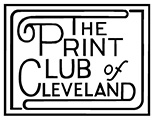GLOSSARY OF PRINTMAKING TERMS
To create an original fine print, the design is drawn on a matrix (woodblock, metal plate, or stone, for example) that is inked. Under pressure the design is transferred to a sheet of paper or other suitable material.
A la poupée
A single plate is selectively inked in different colors, using stumps of rag known as a poupée.
After
When a printmaker uses the design (often a painting or drawing) of another artist as a basis for a print.
Aquatint
Fine particles of acid-resistant resin are deposited on the plate and heated so they adhere to the surface. The plate is immersed in acid, which bites into the metal in very small pools around each particle. The tiny depressions retain the ink and when printed give the effect of a soft grain similar to watercolor or wash.
Catalogue raisonné
A book listing all of the prints by a certain artist. References to it are by the author's last name.
Chine collé
A thin sheet of oriental paper is pressed to a heavier backing sheet when it is put through the press for printing.
Drypoint
Drawing directly on the metal plate with a sharp point creates a rough ridge of metal—a burr—along the groove. When the plate is inked, the burr catches the ink, producing dark, velvety accents.
Embossing
Any process used to create a raised or depressed surface, sometimes without ink.
Engraving
Lines are incised into a metal plate with a burin. The curls of metal thrown up at the sides of the furrow are cleaned away with a scraper.
Etching
A metal plate is coated with a varnish-like substance (known as the “ground”) that is impervious to acid. The artist creates an image by drawing through the ground with an etching needle, exposing the metal. The plate is immersed in acid, which bites grooves where the metal has been exposed. The ground is removed, and the plate is ready to be inked and printed.
Intaglio
Lines are sunken grooves in the plate, as in engraving or etching.
Linoleum cut (or linocut)
A relief technique like woodcut, but using linoleum rather than wood.
Lithograph
The design is drawn on a stone (or certain types of plates) with a greasy crayon or ink. Water adheres to the bare stone but not to the greasy areas, while the printing ink does the opposite; it sticks to the greasy areas but not to the wet stone, reproducing the design when printed.
Mezzotint
The metal plate is systematically worked over with a spiked tool called a rocker until it is thoroughly roughened. If inked now it will print a solid black. Working from dark to light, texture is removed from the plate with a scraper. The smoother the area is, the less ink it will hold, creating an image in a range of tones.
Monotype
Ink or paint is applied to a smooth plate. Because there is no fixed matrix, only one strong impression can be printed.
Offset lithography
The image is transferred from the stone or plate to a roller on the press, which then prints the inked image onto the paper.
Photomechanical reproduction
Various printmaking processes in which the imagery is established photographically.
Planography
The design is created on a flat surface with no perceptible variation in depth, as in lithography.
Plate tone
Tone created in intaglio prints by leaving a film of ink on the plate when it is wiped before printing.
Relief
The image is printed from the raised portions of a carved, etched, or cast block or other rigid material. The printing surface stands in relief above the rest of the block, as in woodcut.
Roulette
A tool with a spiked wheel used to incise lines of even dots on intaglio plates.
Screenprint (also called serigraph or silkscreen)
Silk or synthetic mesh is stretched tightly over a frame. A stencil is adhered to the fabric, blocking the nonprinting areas. The image areas are open fabric through which ink is forced with a squeegee.
Softground etching
The artist draws with a pencil on a piece of paper that is placed over a special soft etching ground. The pressure of the pencil causes the ground to adhere to the paper, recording the texture of the paper on the plate. The plate is then bitten with acid, the remaining ground is removed, and the plate is inked and printed.
State
Any stage in the development of a print at which impressions are taken. A change of state occurs only when the plate is modified in any way.
Steelfacing
The process of coating a metal plate with a thin layer of steel by electrolysis, which strengthens its surface for further printing.
Stencil (or pochoir)
Prints are hand-colored through specially cut stencils.
Stipple
In etching and engraving, a method of rendering tone by means of dots and short strokes.
Sugarlift aquatint
The artist draws on the metal plate using a mixture of sugar syrup and ink. When dry, the entire plate is covered with a varnish that is impervious to acid and then placed in warm water. As the sugar melts, it lifts off the varnish and exposes the metal plate where the artist had drawn. These areas are then aquatinted.
Woodcut
The areas around each line are cut out of the block of wood so that the lines to be printed stand out in relief.
Wood engraving
The artist cuts into the end grain of a hard wood using a sharply pointed instrument called a burin. The surface of the block is inked and printed, producing white lines on a black background.
